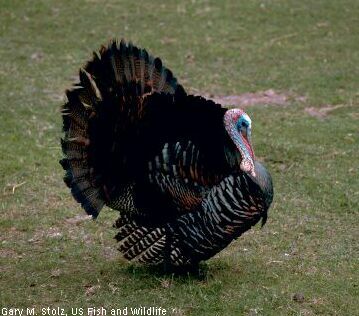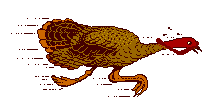
Eastern Wild Turkey

- The wild turkey is a "chicken-like" bird, related to the grouse, quail and pheasant. It is the largest game bird in North America. The wild turkey does not look like the turkey that is raised on farms. It is smaller in size with smaller breast, longer legs and neck. Turkeys raised on farms have white feathers.
- There are five kinds of wild turkeys in North America. The Eastern Wild Turkey is the most plentiful.
- males - gobblers or toms
females - hens
young - poults
- Location - found in southern Canada, the U.S. and central areas of Mexico;
lives in wooded areas, roosts in trees at night.
In winter the turkey lives deep in the woods.
In summer it can be found at the edge of the woods, in forest clearings and near farms.
Their colors help them blend in with the surroundings.
- Appearance - very large bird with a small bluish-gray head and reddish throat and neck; brownish in color with colorful feathers that gleam in the sunlight; colorful long brownish-green wings (with bars); long tail, dark and fan-shaped with light band at the tip.
A female's (hen) feathers are duller and not as colorful; the male's feathers are brighter and shinier.
The adult male (tom) has a larger head which is almost bare; the hen has fine feathers on her head.
Males have spurs (spur - a sharp, bony spike on the back of each leg) that are used when fighting; hens do not.
The males also have beards (long black feathers) on their chests; hens usually do not have beards.
- Size - Adult males can be almost a meter tall (about 2 1/2-3 feet tall), Gobblers can weigh up to 11 kg (25 pounds), averaging about 8 kg (17 or 18 pounds).
Females (hens) are shorter and weigh about half as much - around 4 kg (9-10 pounds).
- Food - mainly plants (buds, leaves, stems, roots, and tubers); seeds,corn, grains, nuts (acorns, beechnuts), wild fruits and berries, insects (grasshoppers) and spiders. During winter they feed on seeds, nuts and fruits left over from autumn. The whole nuts and pebbles they eat help their gizzard to grind up food.
- adaptations
keen eyesight and hearing
dark colored feathers blend in with their surroundings
swim, run and fly
fly an estimated 40-55 mph (up to 88 k/hr) for short distances
can cover more than a mile while airborne
run quickly on long powerful legs (up to 18 m/hr or 29km/hr for short distances)
fly into trees to spend the night
flock of 6 to 40 birds may roost in the same tree or in nearby trees
Early in the morning, they glide to the ground, call, and gather together for feeding.
- communication
can make alot of sounds.
best known is the male's "gobble"
Other calls include yelps (keouk, keouk, keouk);
the cluck(kut), a call to group together;
the whistle (kee-kee run) of a young bird;
the alarm or warning (putt)
Hunters use calls to attract the birds.
- showing off (to attract the hens)
A gobbler will fan his tail and puff up his feathers.
He tucks his head back against his body.
He struts back and forth, hissing and dragging his wings on the ground.
This is called strutting.
- fighting
The males fight for females.
Each male grasps the other's head or neck in his bill
They try to knock each other off balance.
The first bird to let go or lose balance gets hit with the wing and spur.
The spur (on the leg) is like a spike that curves upward.
A spur can grow as long as 3.175 cm.(1.5 inches).
- nest and eggs
In late April, the females leave the flock.
They find nesting spots in wooded or brushy areas, close to clearings and near water.
The nest is a dent in the ground lined with some leaves and grass.
It may be hidden under a fallen log or branches, or in shrubs or grass.
A hen lays an egg nearly every day until her nest contains 8-15 (average is 12).
The eggs are oval and pointy at one end.(size: 2.5 inches, 63mm)
Eggs are light tan with brownish specks or dots.
It takes about 28 days for an egg to hatch.
- young turkeys (poults)
They are covered with fine, brownish fuzz.
They have many enemies so must learn to run and hide.
Poults will hide and freeze when the hen gives a warning call.
The hen leads them from the nest to open areas to feed.
The poults feed on insects (grasshoppers, crickets, and others), green plants and fruits.
After two weeks their wings develop and they can leave the nest and roost in trees.
After three weeks the hens and poults join a flock.
By age of six weeks, the poults are good fliers.
- enemies
Foxes, bobcats and great horned owls prey on nesting hens.
Eggs are eaten by foxes, bobcats, owls, minks, raccoons, opossums, black snakes, skunks, crows and red squirrels.
A hen may pretend to be injured to lure the enemy away from her young.
Coyotes, foxes and fishers are the main enemies of the adults.
- turkey population
Settlers hunted wild turkey for food and cleared away the trees so they could have land for farming. More trees were cleared so towns could be built. Game hunters killed more than they needed. Logging destroyed alot of the woodlands where the wild turkeys lived.Their numbers dropped from millions to about 30,000 By the early 1900s the wild turkey nearly disappeared. State governments passed hunting laws to limit the number of turkeys killed. Turkeys were also moved to places where they had disappeared and the numbers grew.
In Canada the wild turkey was nearly wiped out. Their numbers have increased due to strict hunting laws and by reintroducing wild turkeys to certain areas.

Eastern Wild Turkey - Gary M. Stolz,
US Fish and Wildlife Service

page by J.Giannetta (jgiannet@hotmail.com)
Oct/03 (updated 2011)
Web Pages for Students
Eggs - Theodore D. Leninger,
USDA Forest Service
turkey head - photo courtesy of USDA